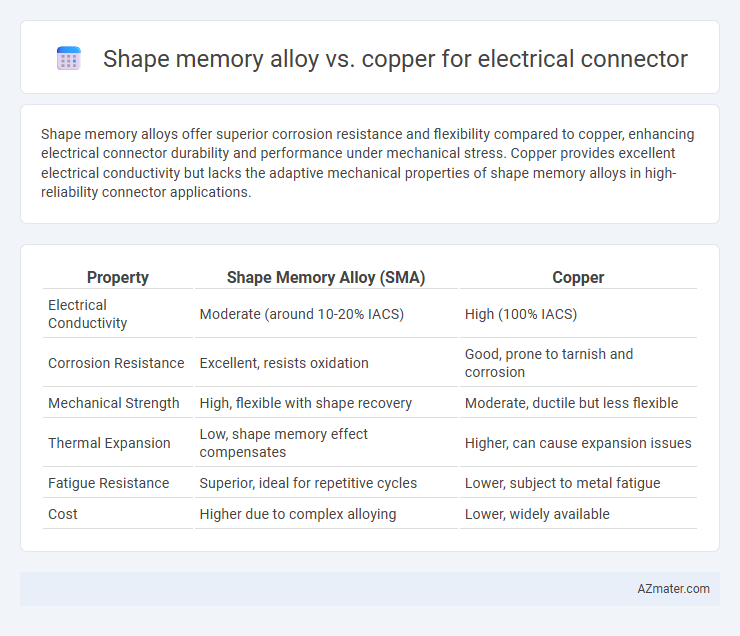Shape memory alloys offer superior corrosion resistance and flexibility compared to copper, enhancing electrical connector durability and performance under mechanical stress. Copper provides excellent electrical conductivity but lacks the adaptive mechanical properties of shape memory alloys in high-reliability connector applications.
Table of Comparison
| Property | Shape Memory Alloy (SMA) | Copper |
|---|---|---|
| Electrical Conductivity | Moderate (around 10-20% IACS) | High (100% IACS) |
| Corrosion Resistance | Excellent, resists oxidation | Good, prone to tarnish and corrosion |
| Mechanical Strength | High, flexible with shape recovery | Moderate, ductile but less flexible |
| Thermal Expansion | Low, shape memory effect compensates | Higher, can cause expansion issues |
| Fatigue Resistance | Superior, ideal for repetitive cycles | Lower, subject to metal fatigue |
| Cost | Higher due to complex alloying | Lower, widely available |
Introduction to Electrical Connectors
Electrical connectors require materials with excellent conductivity and mechanical reliability; copper is widely used due to its superior electrical conductivity and ease of fabrication. Shape memory alloys (SMAs) offer unique advantages in electrical connectors by providing flexibility, self-healing contact, and resistance to mechanical fatigue while maintaining adequate conductivity. Choosing between copper and SMAs depends on specific application demands, including environmental conditions, mechanical stress, and connector durability.
Overview of Shape Memory Alloys
Shape memory alloys (SMAs) exhibit unique properties like superelasticity and the ability to return to their original shape after deformation, making them ideal for electrical connectors requiring high reliability and durability under mechanical stress. Compared to copper, SMAs provide enhanced corrosion resistance and can maintain stable electrical connections despite thermal expansion or mechanical cycling. Their adaptability and resilience in extreme environments make SMAs advantageous for specialized applications where conventional copper connectors may fail.
Properties of Copper in Connectors
Copper offers exceptional electrical conductivity approximately 5.8 x 10^7 S/m, ensuring minimal resistance and efficient current flow in electrical connectors. Its high ductility and excellent thermal conductivity enhance connector durability and heat dissipation, preventing overheating during operation. Copper's corrosion resistance and mechanical strength ensure reliable long-term performance in various environmental conditions.
Electrical Conductivity Comparison
Shape memory alloys (SMAs) typically exhibit lower electrical conductivity compared to copper, with copper having a conductivity of approximately 5.96 x 10^7 S/m, making it one of the best conductors used in electrical connectors. The inherent metallurgical structure of SMAs, such as nickel-titanium alloys, introduces higher resistivity due to atomic arrangement and phase transformation mechanisms. For applications demanding minimal electrical resistance and maximum current flow, copper remains the preferred choice over shape memory alloys.
Mechanical Performance and Flexibility
Shape memory alloys exhibit superior mechanical performance compared to copper in electrical connectors due to their high fatigue resistance and ability to return to their original shape after deformation, enhancing connector durability. Copper offers excellent conductivity but lacks the flexibility and resilience of shape memory alloys, making it more prone to permanent deformation under mechanical stress. The unique elasticity and shape recovery properties of shape memory alloys result in improved mechanical flexibility, critical for connectors subject to repeated mechanical cycling.
Corrosion Resistance and Durability
Shape memory alloys exhibit superior corrosion resistance compared to copper, maintaining performance in harsh environments due to their oxide layer that prevents degradation. Their durability surpasses copper's by offering enhanced fatigue resistance and retaining mechanical properties under cyclic stress, ideal for reliable electrical connectors. Copper, while highly conductive, is more prone to corrosion and mechanical wear, potentially compromising long-term connector integrity in challenging conditions.
Cost Analysis: Shape Memory Alloy vs Copper
Shape memory alloys (SMAs) generally have a higher initial cost compared to copper due to complex manufacturing processes and material scarcity. However, SMAs offer long-term savings in electrical connectors by reducing maintenance and replacement costs owing to their excellent corrosion resistance and self-healing properties. Copper remains a cost-effective choice for large-scale applications with lower upfront material expenses but higher lifecycle costs in harsh environments.
Application Suitability in Electrical Systems
Shape memory alloys (SMAs) offer superior elasticity and self-recovery properties, making them ideal for connectors requiring frequent thermal cycling and mechanical stress resilience, such as in aerospace and automotive electrical systems. Copper excels in electrical conductivity and thermal management, providing efficient current flow and heat dissipation, which suits high-load power distribution and general electronic devices. Selecting between SMA and copper connectors depends on specific application demands like flexibility, conductivity, and environmental endurance in electrical systems.
Environmental Impact and Sustainability
Shape memory alloys (SMAs) offer superior environmental benefits compared to copper in electrical connectors due to their durability, reducing the need for frequent replacements and minimizing electronic waste. SMAs are often made from recyclable materials like nickel and titanium, enhancing sustainability by enabling efficient material recovery at end-of-life. Copper extraction and processing have a higher carbon footprint and ecological impact, making SMAs a more environmentally friendly choice in sustainable electrical connector applications.
Future Trends in Connector Materials
Shape memory alloys (SMAs) offer promising future trends in electrical connector materials due to their unique properties like high elasticity, self-healing capabilities, and resistance to corrosion, which outperform traditional copper connectors in harsh environments. Advances in nanotechnology and alloy composition are enhancing the electrical conductivity and durability of SMAs, driving innovation in smart connectors for aerospace, automotive, and IoT applications. While copper remains a cost-effective and widely used material with excellent conductivity, the integration of SMAs is expected to revolutionize connector performance by providing adaptive mechanical and electrical characteristics crucial for next-generation electronic systems.

Infographic: Shape memory alloy vs Copper for Electrical connector
 azmater.com
azmater.com